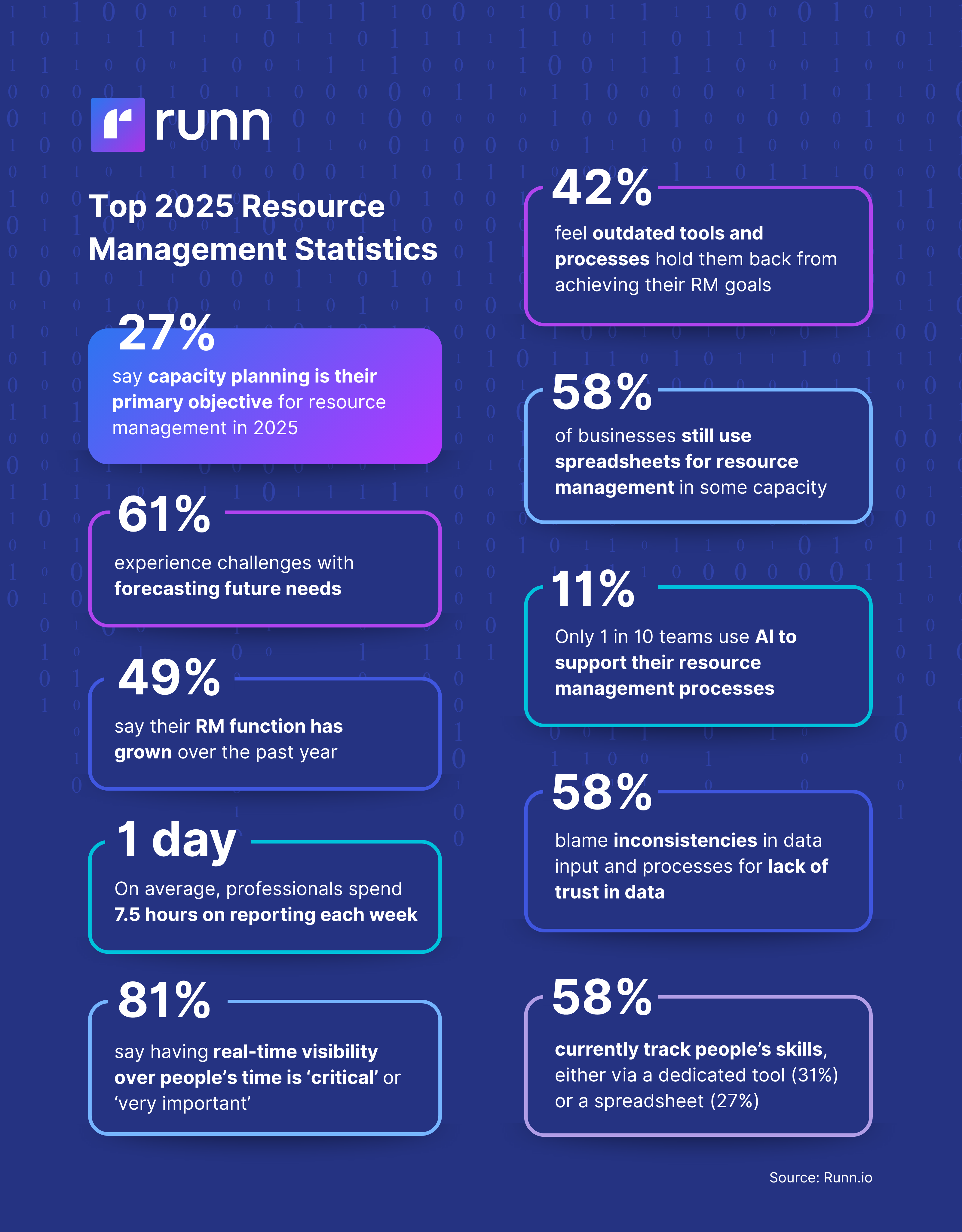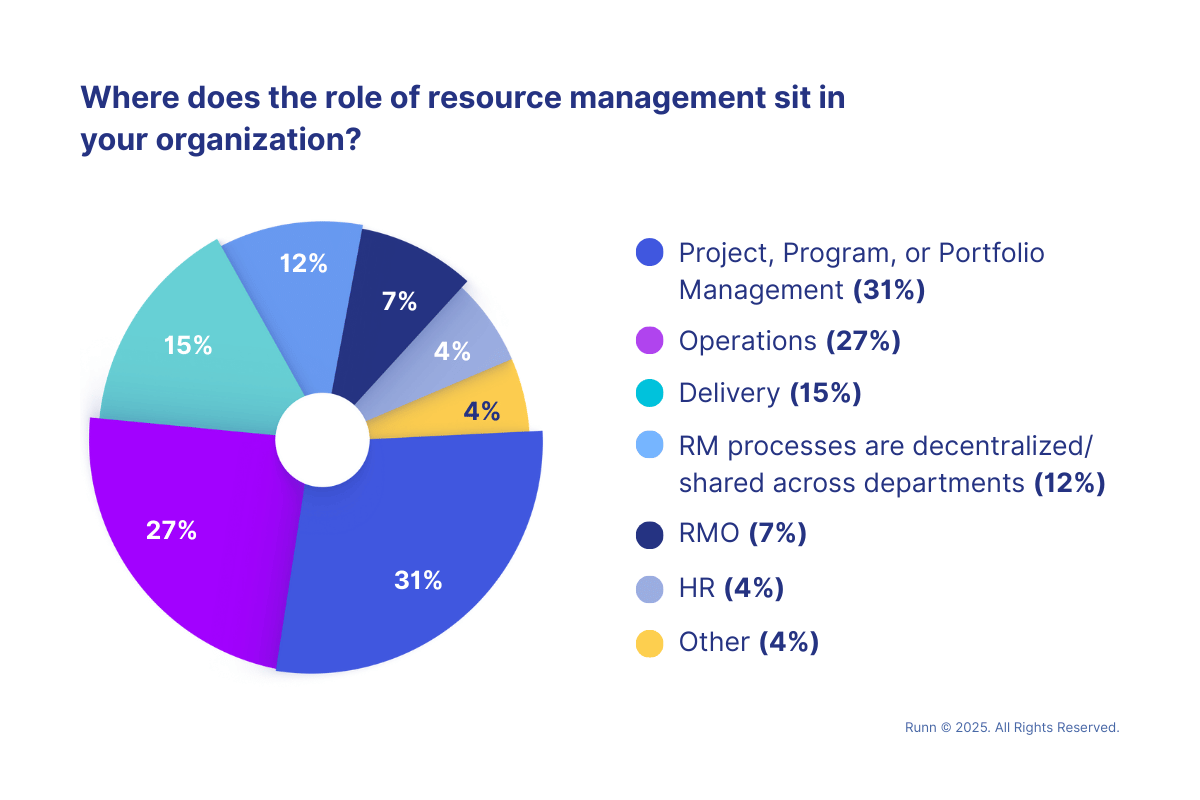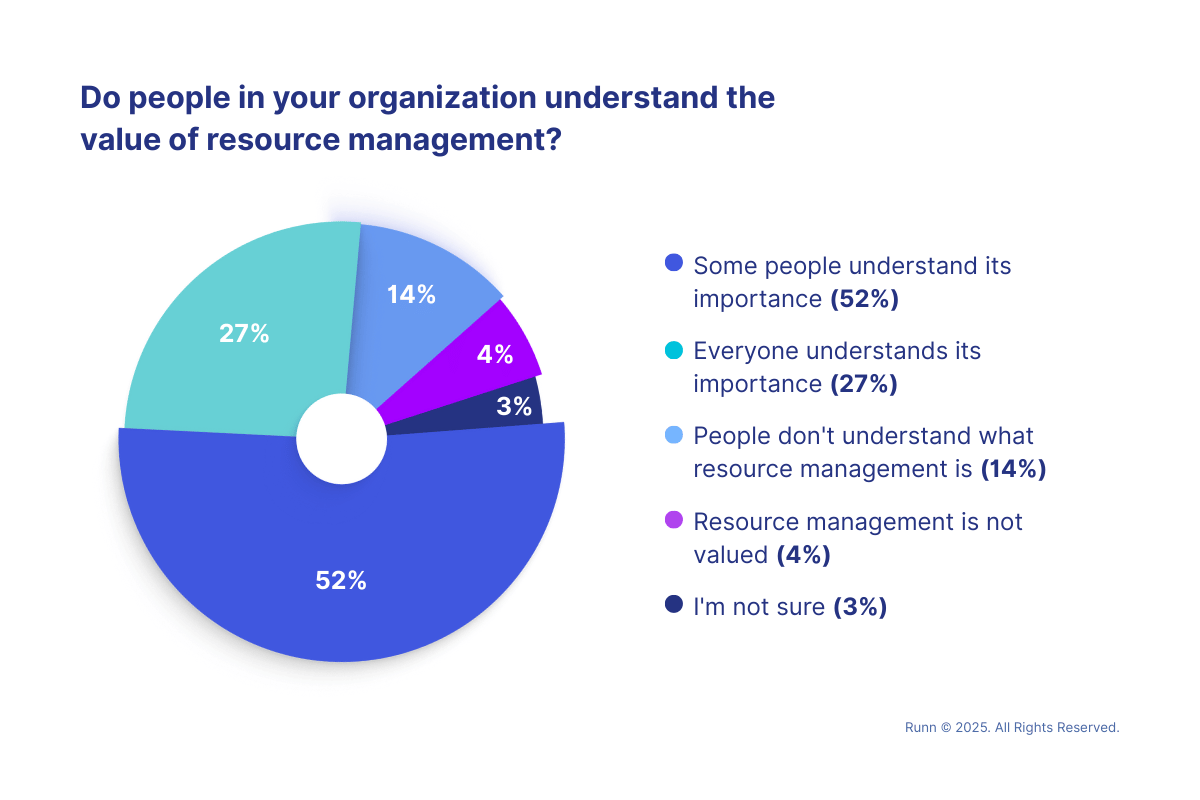Discover the state of resource management with insightful statistics. Explore current trends and challenges in optimizing organizational efficiency.

Resource management statistics do more than tell a story. They can shape strategy and inspire success.
So, this year, we decided to reach out to our incredible network of talented resource managers and take the pulse of the profession. Runn’s The State of Resource Management in 2025 Report is packed with resource management stats to help sector professionals benchmark their maturity and take action to improve.
Dealing with change is a huge part of resource management, from rescheduling around scope creep to reprioritizing resources when clashes occur. But, behind the scenes, RM’s evolution can feel glacial.
Resource management is often misunderstood and undervalued. Teams remain under-resourced (ironically). And everyone still confuses you with HR!
However, in our resource management research, we spotted promising signs of change now and on the horizon.
In this article, we're going over the latest resource management statistics – and evergreen insights – to see what’s changed in the profession, what still needs work, and how you can raise your game.

In an economic landscape characterized by unpredictable demand, talent supply problems, and financial pressures, it’s no surprise that better capacity planning is the top objective for resource management in 2025, with 27% of respondents citing it as their top priority.
When you add in the 20% who said ‘improving utilization’ and 14% who said ‘strategic workforce planning’, and that’s over half of you using resource management to better align staff supply to client demand.

Struggling to balance capacity with demand isn't a new problem.
In a 2022 report by Deltek, 49% of agency leaders said they were prepared to allocate significant funds for hiring more talent. Though hiring human resources and employee retention was a high priority, planning those resources was the leading operational challenge for agencies.
When describing the challenge, 34% agreed they struggle with knowing they have the right amount of full-time and freelance staff to match new business pipeline and expected revenue.
Deltek found that while many companies used resource management technology, in most cases it was dispersed (56%) – and only 38% of participants used a centralized system.
Our resource management research revealed the same problem.
When asked what the biggest inhibitors were to effective RM, many highlighted struggles with outdated tools and manual processes.
42% of teams are being held back by legacy systems that just don’t work. When we consider the 31% who identified challenges with siloed departments and 25% who pointed to decentralized processes, it’s clear a lack of cross-departmental collaboration continues to cast a shadow over efforts.

Other challenges include:
In 2022, Deltek also identified visibility as one of the biggest challenges for resource managers, with 41% of respondents struggling with clear sightlines into available resources.
Considering 81% of organizations consider real-time visibility into people’s time to be critical or very important, it’s essential these challenges are overcome.

Could lack of investment be the reason why these challenges aren’t getting resolved?
Our 2025 research found that, despite 64% of respondents naming improving resource allocation and scheduling accuracy a top priority, only 16% had plans to implement more advanced resource management software this year.
This is a false economy that could be costing businesses more than it saves.

Organizations’ resource management priorities for 2025:
The top challenges organizations want to solve with resource management:

Improving utilization followed capacity planning as the second-most highly prioritized resource management objective in 2025, with 20% citing it as their top priority.
What’s more, 60% said they had had their sights set on increasing resource utilization and productivity this year.
But caution should be taken. Good resource managers want to increase utilization, but great resource managers know balance is important.
Overcommitted resources – those with a utilization rate of 125% – are proven to cause project delays. The recommended rate for successful project delivery? Around 80%.
So, how do you ensure you find this all-important balance? The Resource Management Institute recommends measuring utilization weekly or monthly in order to spot and address negative trends early on.
However, the ability to do this accurately relies on access to reliable, real-time data for resource management – something our RM statistics suggest is a challenge for many.
Only 10% wholly trust their resource data, while 8% don’t trust their data at all. It’s no wonder 21% of companies said their forecasting capabilities are not effective!
.png)
58% of those who struggle to trust their data say this is due to inconsistency in data input and processes, while 25% point to incomplete data sets. A further 17% blame data being spread across multiple tools.
.png)
This suggests a lack of centralization, both in terms of tech and teams. A centralized resource management platform would provide much-needed data consistency and accuracy.
Not only that, but it would help reduce the 7.5 hours a week resource managers spend, on average, on reporting. Yes, one day a week is currently spent on reporting.

In 2022, Prosymmetry found 56% of enterprises use one or more tools for resource management, with 62% placing particular value on the ability to forecast skills gaps.
Skills tracking is essential, but isn’t the end goal in itself. What’s most valuable is the decisions you can make when you have access to robust skills data:
However, the Resource Management Institute found that, although 92% of respondents to their 2022 survey had technology to store skills-related data, 35% didn’t track project or career interests of delivery personnel. This is a missed opportunity.
What about today? Our statistics found that 31% of respondents want to use RM to solve issues with underutilized teams and skills.
Yet, just 58% currently track skills. Of the 42% that don’t track skills, two-thirds want to begin doing so. Only 14% have no plans to implement skills tracking. Perhaps in 2026 they’ll be convinced of the immense value in matching talent to projects, delivery outcomes, and staff satisfaction.
Looking to the future, AI tools offer huge opportunities for tracking, evaluating, and utilizing people’s skills. Yet, we’re a long way off this being a central part of most business’s resource management processes.
Our survey found just 1 in 10 businesses use AI to support their resource management processes. However, there is an appetite for AI capabilities, with 46% considering adopting such features in the future. We can to see expect an uptick in the number of organizations utilizing AI as new features are developed and launched.

Let’s take a look at how resource management teams are working in 2025.
More than half of respondents report their organization takes a reactive approach to resource management. Reactivity often stems from deeper issues, such as outdated tools, untrusted data, and excessive time spent on manual processes.

Despite the growing availability of dedicated resource management tools, the humble spreadsheet remains a staple for over half of resource managers.
Almost half of respondents have adopted fit-for-purpose resource management software, and 38% of those using spreadsheets also use a dedicated resource management tool.

Spreadsheets provide a great starting point for businesses that rank at Levels 1 or 2 on the RMI’s Resource Management Maturity Model.
Nearly half (43%) rated themselves at Level 3 — operationally sound but seeking to elevate resource management to a strategic function — while a modest third placed themselves at a Level 2, pointing to reactive allocations and a fragmented approach. Few placed themselves at either extreme: just 4% at Level 1, where resource management is ad hoc, or Level 5, where resource management is fully integrated with strategic goals.

It’s a common misconception that resource management is only a requirement for bigger teams. However, over a third of our respondents said they manage resource pools of fewer than 50 people.

In many businesses, resource management is looking for a dedicated home. Only 7% of our survey respondents work within a dedicated Resource Management Office, with the rest absorbed into either project management (31%), operations (27%), delivery (15%), or HR (7%). 12% report RM processes being decentralized or shared across departments.

The value of skilled resource managers cannot be overstated. They save business costs, make sure projects get delivered on time, and keep employees happy with their assignments.
The good news? Our resource management statistics revealed the resource management discipline growing. Over four in five resource management functions have grown or remained stable in 2025, suggesting greater recognition for the benefits it brings to the business.

In fact, the value of resource management is either totally understood or somewhat understood in 79% of businesses. Only 4% of people say RM is not valued in their organization.

As this practice grows in importance, we can expect the RM role to evolve too. Here are some interesting statistics from the RMIs research on the profession:
If one thing’s been made clear by our research, it’s that many resource management challenges can be solved by appropriate technology, tools, and processes.
With a fit-for-purpose tech stack, you can make the most of:
✅ Advanced capacity planning tools
✅ Visibility into resource availability and skills
✅ Intuitive data visualisation and trends
✅ Automated reporting from real-time data
✅ Centralized skills management
Continue reading: